#halloween i guess idk
Text
Didn't wanna clog up your post, and these sources are more about relationships of time with space/place, but here's some stuff that I've encountered:

---
“Temporal sovereignty”. Contemporary US/Australian claims over time-keeping. Reclaiming agency by operating on Indigenous/alternative time schedules. The importance of the “time revolution” in the Victorian era to Euro-American understandings of geology and deep past, precipitating nineteenth-century conquest of time. Mid-twentieth century understanding of “deep time” and its co-option by the Australian state. "Deep time dreaming".
Laura Rademaker. “60,000 Years is not forever: ‘time revolutions’ and Indigenous pasts.” Postcolonial Studies. September 2021.
---
How "time is a form of enclosure". Checkpoints, "baroque processes to apply for permits to travel", fences, incapacity to change residences, and other "debilitating infrastructures" work to "turn able bodies into a range of disabled bodies" by "stretching time". This is a "slow death" and a simultaneous "slowing down of life" because "it takes so long to get anywhere" and "movement is suffocated". Thus "time itself is held hostage". This "suspended state" of anxiety and endless wait-times "wreaks multigenerational psychological and physical havoc". "Checkpoints ensure one is never sure of reaching work on time. Fear of not getting to work then adds to the labor of getting to work [...]. Bodies in line at checkpoints [...] [experience] the fractalizing of the emotive, cognitive, physiological capacities" through a "constant state of uncertainty". "The cordoning of time through space contributes to an overall 'lack of jurisdiction over the functions of one's own senses' [...] endemic to the operation of colonial rule". This "extraction of time" produces a "depleted" and tired person "beholden to the logistics" of administrative apparatuses, community suffers and "communing is thrawted".
Jabir K. Puar. "Spatial debilities: Slow Life and Carceral Capitalism [...]." South Atlantic Quarterly 120. April 2021.
---
The "apocalyptic temporality" that presumes extinction. Indigenous Polynesian/Pacific perceptions and ways of being "destabilize the colonial present" and also "transfigure the past" by "contesting linear and teleological Western time". Indigenous "ontologies of cyclical temporality or inhabitation of heterogenous time". How United States and Europe colonized Oceania for weapons testing and conquest of tropical Edens while rendering local Indigenous people "ungrievable" and "without future". "Pacific time is a layering of oral and somatic memory". Instead of accepting an apocalyptic future or doomsday or nightmare, assert the possibility of a livable future, in spite of "Western temporal closures".
Rebecca Oh. “Making Time: Pacific Futures in Kiribati’s Migration with Dignity, Kathy Jetnil-Kijiner’s Iep Jaltok, and Keri Hume’s Stonefish.” MFS Modern Fiction Studies. Winter 2020.
---
Colonial "space-time homogenization". The experience of "homogenous, empty time". Orientalist "time lag" and the naturalization of a supposed East-West hemispheric divide. Late Victorian imperial conceptions of temporality. The British establishment of the Greenwich meridian and International Date Line. The influence of British imperial seafaring and cartography on the establishment of time and on European/US feelings towards the Pacific Ocean. How the origin of English science fiction literature, space travel aspirations, and time travel narratives coincided with the Yellow Peril and xenophobia targeting East Asia.
Timothy J. Yamamura. "Fictions of Science, American Orientalism, and the Alien/Asian of Percival Lowell". Dis-Orienting Planets: Racial Representation of Asia in Science Fiction. 2017.
---
Imprisonment as time-control. Here “the question of the past the present and the future indeed time itself looms” especially around the prisoner. “The law renders punishment in units of time”, taking away a the right to a future. There are alternative worlds, many of them, which have been practiced and brought into being, which colonization tried to obscure. There is “a whole anthropology of people without future embedded in the assumptions that justify mass imprisonment as poverty management”. "The prison’s logic exterminates time as we know it”. In prison, bodies have been alienated from time and history ... the punishment seems endless ... to “achieve a measure of agency and possibility it is necessary to redeem time”, to refuse the doom, fated to a life of abandonment.
Avery Gordon. “Some Thoughts on Haunting and Futurity.” borderlands. 2011.
---
Bursting the Limits of Time: The Reconstruction of Geohistory in the Age of Revolution (Martin J.S. Rudwick, 2010) explores how the advent of European sciences like geology, preceding the "time revolution" when Europeans experienced revelations about the scale of "deep time", happened alongside and after the Haitian Revolution and other abolitionist movements. French, German, and British naturalists translated the explosion of "new" scientific knowledge from the colonies, so that the metropolitan European audience became a market for historical and scientific "narratives" about how "nature" and time functioned.
---
Prartik Chakrabarti's writing on time, temporality, and "the deep past" as British imperial concepts built in conversation with colonial encounters with South Asia. (British Empire reaching such heights in the middle of the nineteenth century at the same time that the newly professionalized sciences of geology were providing revelations about the previously unknown vast scale of "deep time". New colonial anthropology/ethnology also presumed to connect this "primitive" past with "primitive" people.)
See Chakrabarti's "Gondwana and the Politics of Deep Past". Past & Present. 2019.
---
We must witness and consider "multiple space-times" to understand how "unfree labour" of plantations was "foundational" to contemporary work, movement, subjugation, health, etc. We must "trace the geneaology of contemporary sovereign institutions of terror, discipline and segregation" [workplaces, imperial/colonial nations, factories, mines, etc.] back in time to plantations. How "the [plantation] estate hierarchy survives in post-plantation" times and places, with the plantation "being a major blueprint of socialization into [contemporary] work". The plantation was "a laboratory for [...] migration regulation in subsequent epochs" that practiced methods of racializing and criminalizing.
Irene Peano, Marta Macedo, and Colette Le Petitcorps. "Introduction: Viewing Plantations at the Intersection of Political Ecologies and Multiple Space-Times". Global Plantations in the Modern World: Sovereignties, Ecologies, Afterlives. 2023.
---
“Slow life” and the relationship between “settler colonialism, carceral capitalism, and the modulation of ... registers of time,” including “historical time, the stealing of time through the expansion of labor time, ... and the cordoning off of space through time”. For example, as in occupied zones or at border checkpoints, “the cordoning off of space through time” includes physical architecture like fences and customs, obstacles that impede movement and rhythm, so that “nothing ever happens on time” and there is “a stretching of time”. All the wasted time spent in line, showing papers, waiting for confirmation, etc. “is not a by-product of surveillance, it is the point of surveillance”. Such that “uncertainty becomes a primary affective orientation ... flesh as felt” with a racializing effect“. "This is a biopolitics conditioned through pure capacitation and its metrics”:
Jasbir Puar. In: “Mass Debilitation and Algorithmic Governance” by Ezekiel Dixon-Roman and Jasbir Puar. e-flux Journal Issue #123. December 2021.
---
"Starfish time". Indigenous Australian/Aboriginal perceptions of time and "attending to more-than-human agencies of time". Acknowledging the timescales of entire ecosystems, as part of multispecies relationships, a "transcorporeal collaboration". Cyclical time vs linear time. Contrasting timescales experienced by insects that only live a few days and creatures that live for decades. "Starfish may seem to be still" but they slowly move; "larval time" and "the time it takes for eggs to develop and hatch"'. The "immensity of the alterity is literally incomprehensible"; "we can't know what these beings know" but we "should seek respect and be aware of how our lives are entangled".
Bawaka Country including, S. Wright, S. Suchet-Pearson, K. Lloyd, L. Burarrwanga, R. Ganambarr, M. Ganambarr-Stubbs, B. Ganambarr, D. Maymuru. “Gathering of the Clouds: Attending to Indigenous understandings of time and climate through songspirals.” Geoforum. January 2020.
---
The use of calendars, dates, clocks, and industrial/corporate temporality as fundamental to the rise of plantations and financialization in United States/Europe, with a case study of the modern Colombian/Latin American state. Observance of certain dates and strict adherence to specific calendars support "mythologized deeds and heroic retellings" of colonization and industrialization. “The evolution and internalization of disciplined concepts of time” were intimately tied to the rise of wage labor in industrializing England and later during the global ascendancy of work and industrialized plantation monoculture, but the persistence of alternative time should “serve as a reminder that futures and the demarcation of epochs are never as simple as a neatly organized calendar”.
Timothy Lorek. “Keeping Time with Colombian Plantation Calendars.” Edge Effects. April 2020.
---
Indigenous people of Alaska and the US control over time management. For the past 50 years, Yupiak people have been subject to US government’s “investment in a certain way of being in time” which “standardized the clock” and disrupted human relationships with salmon. This US management model “anonymized care” and made “a way of attending to the life and death of others that strips life of the social and ecological bonds that imbue it” with resilience and meaning, which “ignores not only the temporality of Yupiaq peoples relations with fish, but also the human relations that human-fish relations make possible”. This disregards “the continuity of salmon lives but also the duration of Yupiat lifeworlds ... life is doubly negated” ... “futures depend on an orientation to salmon in the present”.
William Voinot-Baron. “Inescapable Temporalities: Chinook Salmon and the Non-Sovereignty of Co-Management in Southwest Alaska.” July 2019.
---
"Idling" and "being idle" as a form of reclaiming agency and life. Case studies of fugitive Blackness in Caribbean plantation societies. “Disruptive waiting”. “The maroon’s relationship to time challenges [both] the totalizing time of the modern state, but also the [...] narratives to negotiate struggle in the [...] present" in "antagonistic relationship with colonial power". Defying the “European narrative of modernity”. Refusing to be productive.
Amanda Lagji. “Marooned time: disruptive waiting and idleness in Carpentier and Coetzee.” Safundi: The Journal of South African and American Studies. March 2018.
---
Indigenous futures. "It is important to remember that some futures never went anywhere" and "yet they survive. These are futures suppressed and cancelled by colonial power." These are "parallel futures". "Colonial power must control the past so as to deny the emergence of" an alternative future; "colonial power creates a future in advance so that no others will take its place". Poor, racialized, Black, Indigenous people manifest alternative futures.
Pedro Neves Marques. "Parallel Futures: One or Many Dystopias?" e-flux. April 2019.
---
The "legacy of slavery and the labor of the unfree shape and are part of the environment we inhabit". The "idea of the plantation is migratory" and it lives on "as the persistent blueprint of our contemporary spatial troubles", so we must seek out "secretive histories" that no longer "rehearse lifelessness".
Katherine McKittrick. “Plantation Futures.” Small Axe. 2013.
---
“The temporal dispossession” of Congolese people. There is an “impossibility” of “predictable time” because temporal dispossession “disrupts the possibility of building a future”. Livelihoods/income is driven by market and price fluctuations in United States and Europe tech industries, so “there is an inescapable day-to-day sense of uncertainty”. As Mbembe says, “in Africa, the spread of terror ... blows apart temporal frames”.
James H. Smith. ‘Tantalus in the Digital Age: Coltan ore, temporal dispossession, and “movement” in the Eastern Democratic Republic of the Congo.’ American Ethnologist Volume 38 Issue 1. February 2011.
---
“Slow death”. Chronic illness not just as a byproduct of colonialism/dispossession, but also as part of its aim, a weapon that debilitates people, who become exhausted. Dooming poor and racialized people to lives “without future” through debility, “a condition of being worn out”. Relationship of illness, lack of healthcare, and debt as functionally incapacitating, a form of death sentence. A “zone of temporality” unfolding unlike abrupt/sudden traumatic events and becoming an inescapable condition.
Jasbir K. Puar. The Right to Maim: Debility, Capacity, Disability. 2017.
---
The extension of poverty, landlessness, homeless, and imprisonment. "To be unable to transcend the horror of such a world order is what hell means", and "without a glimpse of an elsewhere or otherwise, we are living in hell". The utopian is not only or merely a “fantasy of” and for “the future collectivity” but can be claimed and built and lived here, now. There is "no guarantee" of “coming millenniums or historically inevitable socialisms”, no guarantee that “the time is right” one day if we wait just long enough. Instead: "can a past that the present has not yet caught up with be summoned to haunt the present as an alternative?" The "utopian margins", an alternate world crossing time and place, an "imaginative space and temporality to trace the remains of what "was almost or not quite, of the future yet to come", living as if it were the present. Colonialism tried to crush the many headed hydra of the revolutionary Atlantic, those who challenged the making of the modern world system.
Avery F. Gordon. As interviewed by Brenna Bhandar and Rafeef Ziadah. “Revolutionary Feminisms: Avery F. Gordon.” As transcribed and published online in the Blog section of Verso Books. 2 September 2020. And: Avery Gordon. “Some thoughts on the Utopian.” 2016.
---
The US/European "city is the site of regulatory regimes" that try to impose a definitive narrative about history, progress, and possible futures. But it cannot achieve "a wholly Apollonian, seamlessly regulated realm" because the land "continues to be haunted by the neglected, the disposed of, the repressed". The "commodification" of landscapes "circulates an imaginary geography" mediated through advertisements, labels, soap operas, television, etc. which celebrate "sanctioned narratives and institutionalized rhetoric". A "wild zone" of informal spaces, debris. "Ruins are places where the things, people, and "other memories can be articulated". There is "a spectral residue" that "haunts dominant ways of seeing and being". "Alternative stories might be assembled", so that we can respect the people banished to abandonment, the periphery, and reclaim agency.
Tim Edensor. “The ghosts of industrial ruins: ordering and disordering memory in excessive space.” Environment and Planning D: Society and Space volume 23. 2005.
Also, how "master narratives of history as progress decompose" when faced with "a continuously remembered past" when "the ghosts of this past rear up in the ruin" to expose "the debris of unprecedented material destruction" of colonialism/empire-building. These "hauntings rupture linear temporality" and recall those people beaten down as "the trash of history". It is "essential to see the things and the people [...] banished to the periphery [...]."
Tim Edensor. "Haunting in the ruins: matter and immateriality". Space and Culture Issue 11. 2002.
---
"Many kinds of time" of bacteria, fungi, algae, humans, and "Western colonialism meet on the gravestones". Some creatures, like lichen, are very long-lived and "these temporal feats alert us that modernity is not the only kind of time, and that our metronomic synchrony is not the only time that matters". The "long duree evolutionary rapprochements to the quick boom and bust of investment capital" where "minor forms of space and time merge with great ones". Extinction is "a breakdown of coordinations with reverberating effects". Ghosts remind us that we live in an impossible present, a time of rupture. "Deep histories tumble in unruly graves that are bulldozed into gardens of Progress". "Endings come with the death of a leaf, the death of a city, the death of a friendship".
Elaine Gan, Anna Tsing, Heather Swanson, and Nils Burbandt. “Introduction: Haunted Landscapes of the Anthropocene.” Arts of Living on a Damaged Planet: Ghosts and Monsters of the Anthropocene. 2017.
---
Everywhen: Australia and the Language of Deep History. (Edited by Ann McGrath, Laura Rademaker, and Jakelin Troy. 2023.)
Chapters include: "Bugarrigarra Nyurdany, Because of the Dreaming: A Discussion of Time and Place in Yawuru Cosmology" (Sarah Yu et al.); "Songs and the Deep Present" (Linda Barwick); "Yirriyengburnama-langwa mamawura-langwa: Talking about Time in Anindilyakwa (James Bednall); "Across 'Koori Time' and Space (John Maynard)
#im sorry i guess i accidentally deleted this post so here it is again#colonial#imperial#temporality#abolition#indigenous#multispecies#ecology#temporal#futures#haunted#halloween i guess idk#ecologies#tidalectics#archipelagic thinking#caribbean#victorian and edwardian popular culture#extinction
301 notes
·
View notes
Text

scary
#deltarune#kris#kris dreemurr#fanart#geo art#better late than never to make a halloween icon i guess#i think this is the first time in like a year that i've drawn them w a visible eye lol#idk why i don't .do that more
517 notes
·
View notes
Text
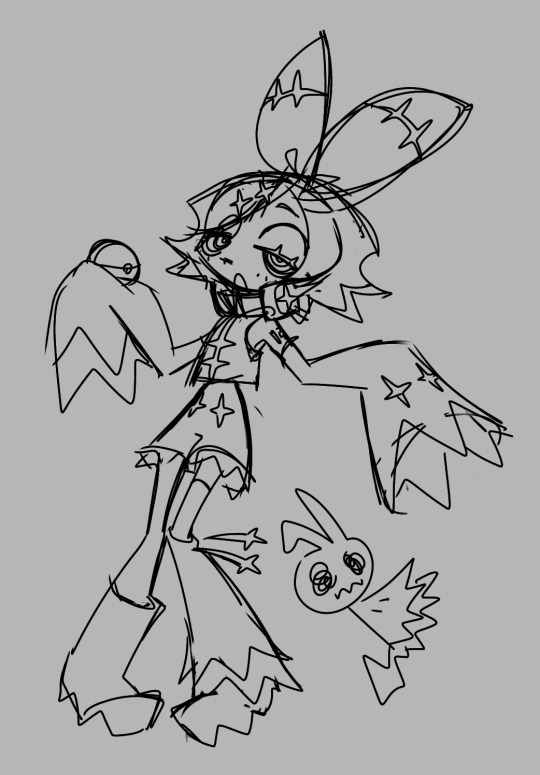
i want to finish this design later, but otherwise here's a sketch of a ghost trainer rin
#zeno's art#vocaloid#vocal synths#kagamine rin#team picks - mimikyu (shes the most popular female vocaloid after miku kinda so i guess its like living in miku's (pika's) shadow??#also that one line in giga-p's bring it on about 'that green girl'#jellicent because they have a twin variant#doublade for a similar reason - its literally an identical pair#uuuuuhhhh driftblim just fits idk#rotom becuz electric angel cover idfk😭#and pumpkaboo because of the hit song happy halloween by junky.#honorable mention is galarian weezing because even though its not a ghost type you could say that its a nuclear power plant#aka meltdown reference#ok im tired now
448 notes
·
View notes
Text
❝ 𝐝𝐫𝐢𝐧𝐤 𝐟𝐫𝐨𝐦 𝐦𝐞 𝐚𝐧𝐝 𝐥𝐢𝐯𝐞 𝐟𝐨𝐫𝐞𝐯𝐞𝐫 ❞

okay … i will stop talking about this and finally post it .... you all did not really think i would get a vampire comm without making myself the vampire did u hehehe ❤︎
by diodoubleg_ on ig who is immensely talented and made me look so beautiful <33 cannot thank her enough !!
#i’ve had it for a while but will finally share so i can use for my halloween theme heheh#CANNOT ! stop staring at it tbh#quote is from my beloved interview with the vampire <33#i contemplated for so long which of my favs to do this with bc my vampire au lore knows no bounds but#human sanji + vampire rylie spawned in my brain back in march and did not let me go#anyway here we are <33#how long before he’s turned into a vampire too idk that’s anyone’s guess
90 notes
·
View notes
Text
Ok but when are getting twst Captain Hook. He's too iconic in the villains lineup to NOT make an appearence. I know it's gonna happen eventually, it's only a matter of time
#twisted wonderland#manifesting peter pan event for next halloween..... captain hook and smee....#i wonder if a possible peter pan event would have a lost boys motif? since pirates was already used for savanaclaw in the first event idk#everybody becomes furry i guess#out of the iconic villains in the dsny villains lineup only cap hook and yzma are left I think?#hope we get yzma and kronk too!!
314 notes
·
View notes
Photo
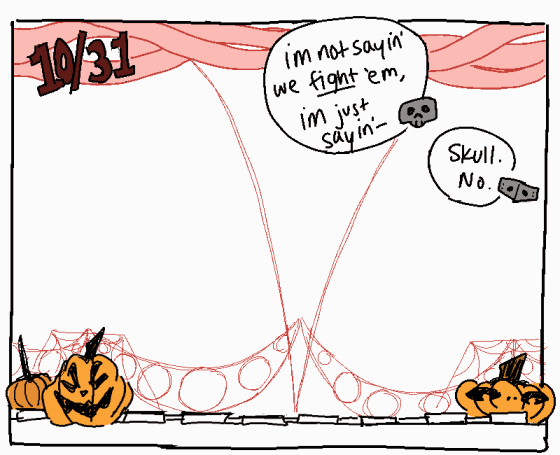
Me? Uploading a Halloween comic on November 18th, almost four whole-ass weeks late???? Yeah that’s uh. yup. yeah



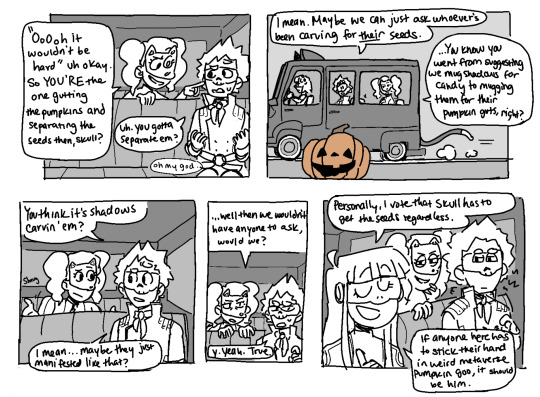
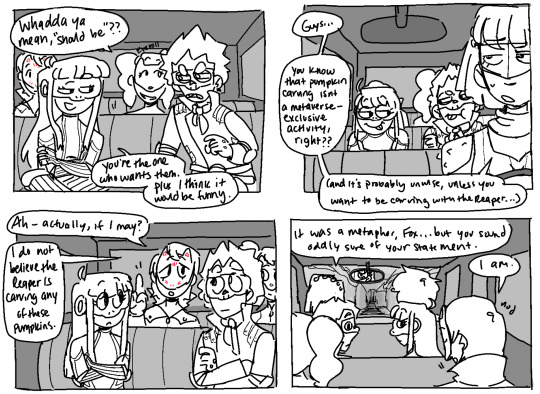
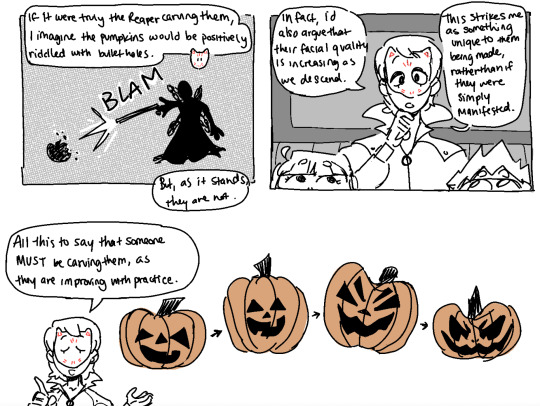


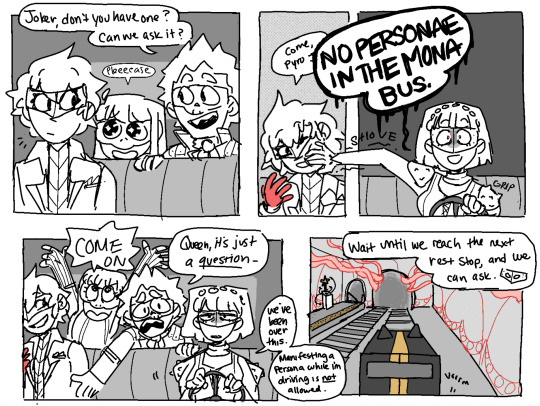
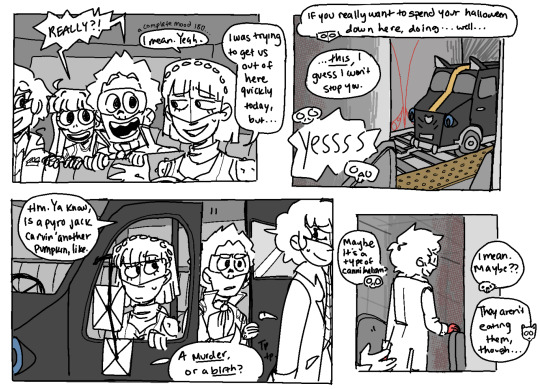
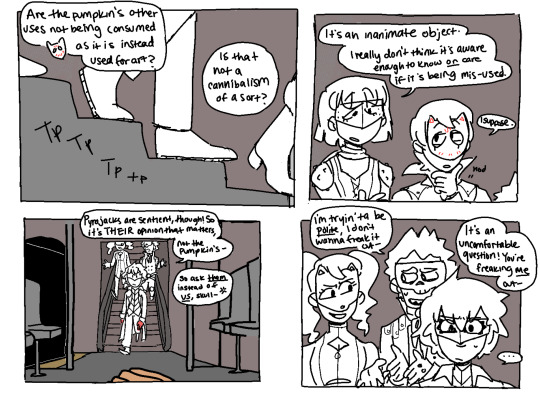
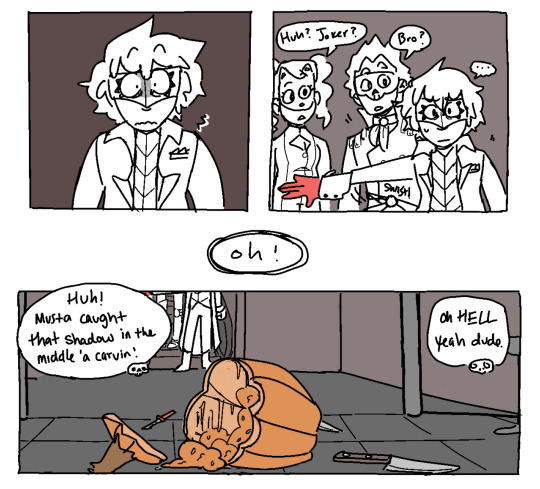
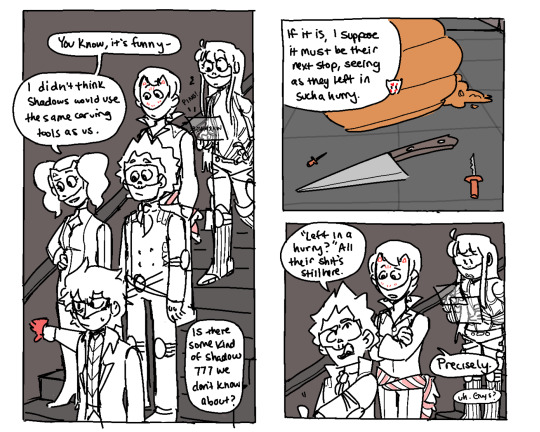
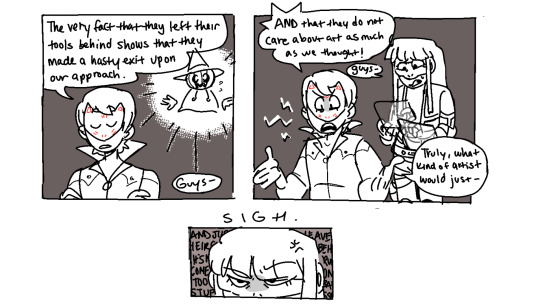





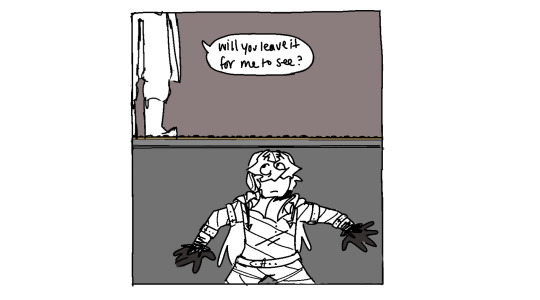





Thanks for reading! :) <3
#persona 5#p5#akira kurusu#OUGH OH MY GOD ITS FINALLY. DONE. I AM LOSING MY MIND#if you've been following me for long enough: yes! this IS in fact the comic i mentioned that i was making last year.#Fun fact! This is also! The Third Draft of said comic!!! i have redrawn this thing THREE FUCKING TIMES#as a result you may notice that i uh. a) gave up on coloring this thing. no way in HELL am i coloring 30 pages. im not...strong enough#you will settle for simply having monochrome colored panels and you will LIKE IT!!!!! >:OOOOO#and b) gave up on backgrounds! yeah fuck that lmao. i am never drawing people in the monabus again and mementos can kiss my ass!!!!!#i just want to draw my silly little characters & not their environments#and you may also say: sophia. by halloween they are already in Sae's palace. why isn't goro with them and where's haru?#and to that i say shhhh suspend your disbelief. akechi is in mementos carving pumpkins to avoid trick or treaters.#and also haru isn't there because i cannot draw 6+ people in a cramped space yet!!! my art skills are Just Not There Quite Yet :(#so she's staying home and handing out fullsized candy bars to kids. that's where she is while this is all going down#'does akira know it's akechi down there?' :) that's up to you! but i WILL say that I was thinking about Akeshu when i wrote this so. :))))#ANYWAY if you read this far in the tags im so sorry lmao. thanks for sticking around! Hope you had a happy halloween :)#hopefully i won't disappear for long this time. idk im just gonna start uploading other bullshit art in the interim between comics i guess#probably some fire emblem shit. we'll see. we'll see. anyway bye!! till next time!
1K notes
·
View notes
Text

In the Spirit of Halloween! // Inprnt
181 notes
·
View notes
Text


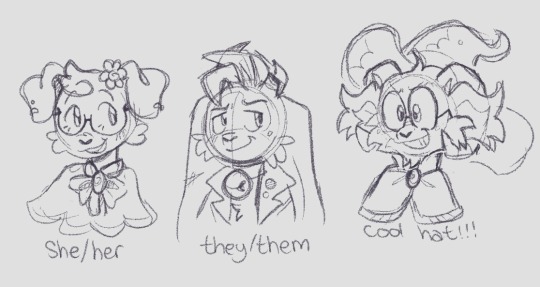
some design comcepts for older lily + lewis!!! my latest and greatest headcanon for them is that in the future they get gems and can do magic of their own :33 i just think it’d be neat,,, something to do with their love of magic!!!! 🥺
#im normal about stdwolom. number one fan have been since i was 15#i need them EXPLODED AND GONE THEY MEAN SO MUCH TO ME BYE#anyways these designs are still. rather up in the air#definitely need some more refining and all that#but yknow!!! for now theyre pretty good kickoff points 🥺#lewis’s fit is loosely based off a wizard fit i gave him in a halloween piece from 2022 hehehe!!#I THINK THEY SHOULD GET MAGIC. I THINK THEY SHOULD AS A TREAT#billie helps them learn ofc!!! AND SO DOES STOTLE. THEM AND THEIR THREE WEIRD KIDS OR WHATEVER#i love them so bad. stdwolom….☹️☹️☹️#dont overthink the gem colours or anything btw. i think theyre just… general ones? question mark?#IDK MAYBE ILL PUT MORE THOUGHT INTO THE SPECIFICS LATER#BUT FOR NOW THEYRE JUST. GENERAL ONES WITH NO SPECIFIC POWERS IN PARTICULAR LMAO#robin’s art#billie bust up#2024 art#bbu billie#bbu lewis#bbu lily#stdwolom#this all started bc i looked at stdwolom and went ‘i think they should be she/her they/them cool hat coded. lewis should get a cool hat’#then i brain blasted.#whats more cool hat than a wizard and whats more wizard than ACTUAL MAGIC#i like to think im smart sometimes#okay hi update these guys are part of my… oc lore? now so uhhh guess theyre getting the story tag#The Panderity Chapter
75 notes
·
View notes
Photo

halloween cosplay
#rick and morty#morty smith#rick sanchez#YES morty is wearing eyeliner to look edgier or older or something IDK#the uhh i guess lore behind this specific moment is rick asking morty for his flash(in coat pocket) and morty hashtag GOING OFF#flask*#or something like that#i drew this before THE halloween day just in case#cause i mite not have time tmrw#but i wanted 2 draw them laik this teehe#cause i love a good fit swap :3
1K notes
·
View notes
Text
Another edit I made because I was bored and had fun with the first one
Warning: Beginning of the song is LOUD
Movie: Lisa Frankenstein
Song: The Day After Halloween - Dead Vampires
#lisa frankenstein#lisa frankenstein spoilers#my edit#the day after halloween#dead vampires#flashing lights#possibly?#idk the tanning bed flashes i guess
43 notes
·
View notes
Note
hiya there sorry if this seems like a big thing to ask of but do you know which sonic characters do have like, official halloween outfits? Like, have been officially published/endorsed by sega.
I know Metal has the Reaper, Shadow has the phantom-vampire hybrid looking costume, Rouge has the witch, Knux has the mummy and Omega is just a big ol' cute pumpkin.
hmm well it depends on what youd count as official by sega i guess, like if youre only counting stuff from games or if other official artwork counts too.. but ill just assume that anything from official media counts. so firstly theres a decent amount of halloween themed sonic channel art that has the characters dressed up:








i think theres at least one more sonic channel wallpaper of reaper metal sonic but im too lazy to track it down.. anyway theres also halloween skins in sonic forces speed battle and theyre all based on existing halloween looks but most of them are a little different from the original, heres the ones that are different:



and sonic usually wears a black cape for halloween art or events, sometimes he has a hat sometimes he doesnt


and theres also a halloween themed cover for an issue of idw sonic, here are the outfits that werent the same ones from existing halloween art:




the outfit amy is wearing is actually based on an outfit from sonic runners but i dont know if it was intended as a halloween thing before so i didnt show it .. also big and froggy are from an early version of the cover the final version replaced them with silver which is why amy and cream are on there twice
and theres also an upcoming idw sonic halloween special, since its not out yet there could be stuff im missing but we do get to see vector espio and charmys costumes in the preview

there could be stuff im missing but this is everything i know about in terms of official halloween costumes for sonic characters
#collection of sonic halloween costume references for your halloween art or fanfiction needs i guess#i also think there might be a few halloween outfits in sonic speed simulator but idk how many are original#and how many are copied from existing art because i dont really play sonic speed simulator#i wanna say rouge has also dressed up as a mummy before in idw sonic but i dont think it was meant as a halloween costume#so i didnt include it. but it is a thing that exists i guess#asks#autusm 👍
66 notes
·
View notes
Text
Whither the man-eater? This entity was once the prime interest of an entire league of famous sportsmen in colonial India, the engrossing content of many books [...]. [T]he man-eater was first constructed, and then dismantled [...]. This erratic rise and fall of the man-eater is descriptive of changing power relations, the ephemeral yet pervasive axis between the colonial and the post-colonial [...].
---
Jim Corbett was a case in point. [Around the time of independence, Corbett authored popular stories of his adventures in colonial India in the preceding decades, including Man-Eaters of Kumaon and The Man-Eating Leopard of Rudraprayag]. [...]
The man-eater was destined [...] to shine in all its ferocity at a certain moment in time and not any other.
Thus, [there is special] context within which specific 'meanings' get associated with animals, at certain times, and at the the hands of select actors [...].
[T]he engulfing realm of the printed word, especially the English book, gave astounding shape and clarity to the idea of a man-eater. [...] The man-eater was never thought of as a sub-species of Panthera tigris in the tables of natural history; rather the man-eater [...] was ‘out of nature’, and thus some kind of an addendum to naturalist understandings. [...] The making of the man-eater into a coherent animal category follows an arduous path. [...] [M]otor cars and other gadgets such as hunting lights had arrived on the scene. [...] [A British officer] who had served in the Central Provinces for quite a while after [1909] [...], commented [..] ‘With modern inventions it would be quite easy to be playing cards in the tent [,] and when the tiger turns up, kill him by pressing a button on a tent wall.’ [His] exasperation was evident [among] [...] [s]portsmen in the 1920s and 1930s [...]. [A] single species splits into undefeatable man-eaters and gentlemanly tigers worthy of observation alone. [...] Amid such lesser sportsmen the man-eater thus became a tactic of power which elevated its [colonial] victor over both the hunters of the past and contemporaries of the present. [...] But it is truly a question if this muzzle-loading gun in the hands of the native [...]. The implication was that sportsmen had a fairer sense of restrictions than the non-sporting classes. With the latter classes gaining political mobility, fears of an 1857-like massacre were also in the air. [...] [B]y the 1930s [...] a host of sportsmen [...] might have preferred to see natives handling a rickety muzzle-loader than an elegant express rifle; the man-eater was intended to remain at large for those ["superior" colonial sportsmen] in possession of the latter. [...]
---
This development of a sportsman into an author can be located within a history of the book. [...] The English novel as a genre [...] began to acquire greater circulation after [...] 1870. [...] [A] book on which the sportsman laboured was like a trophy [...]. For all such ongoing fuss about size [records], a man-eater was more about qualities: cunning, finesse, stealth [...]. If the difficulty of hunting a man-eater was what gave the sportsman a chance to prove the superiority of his skill [...], then this difficulty was the stuff of a story, not a [size] measurement or a mounted trophy. And [...] an aspect of photography. [...] It authenticated the effort of a sportsman and could not be bought of the market [taxidermy trophies available to simply purchase at local shops] except through a book that bore the author’s name. [...]
---
There were dimensions of imagination and power that accompanied this. The idea of a man-eater was such that it helped advance the long held belief that the natives were a hapless lot. [...] Pandian [...] shares how the man-eaters of the colonial period were equated with the ‘arbitrary monarchs’ of a pre-colonial era, which also the British sportsman as a symbol of ‘sovereign might’, would meet on its own grounds. [...] [Consider also] the manner in which the simultaneous depiction of the remaining tigers as ‘large hearted gentlem[e]n’ of the forests (a thing Corbett professed) went to convey the contrary image of a docile, tame and innocent nature that could come to be harmed by natives at the slightest instance.
Protecting the people gave the colonisers power over animals, and protecting animals gave it a power over people.
Notions of animality and criminality intersected at the site of the man-eater.
The entire continuum of man-animal relations was thus canvassed through this tactic, which also the medium of the book in the later colonial periods broadcasted to distant corners of the colony. [...] What perhaps distinguished the man-eater from any ordinary form of game hunting was that it was additionally a form of ‘language-game’. [...] [T]he man-eater was an account in which the ephemeral idea of an ‘India’ glimmered constantly in the background. But it did so largely in English. The man-eater was an English diatribe [...]. The side by side portrayal of the victims of the man-eater as ‘superstitious’, ‘rural’ and ‘ignorant’, only went to establish before the (civilised) readers the proof of an (uncivilised) mass waiting to be salvaged, assimilated or disciplined. [...] [A] mild perusal of Corbett’s My India, published about five years after India’s gaining of Independence, provides ample evidence of the above dynamic. The eventual autonomy of the British administration besides a celebration of the decision making capacities of rural masses (described as ‘real’ Indians) is legend in the pages of this book. The political reality of colonial rule is conflated with a nationalistic pride, which also the sportsman allocates to himself in the describing of his (my?) India. One is left to understand that the man-eater thrived at its best in a colonised India as much as an Indianised colony. As the tension between an emerging nation and an erstwhile colony acquired sharpness in the later colonial periods and a decade thereafter, the narrative of the man-eater came into its own.
The man-eater is thus a veritable creature of timing that shone at its brightest in the 1940s, even if it had been shot down 30 years ago by the likes of Corbett. [...] [Later in the twentieth century, there was a] transformation of the landscape from a designated ‘wasteland’ under colonial administration to a ‘World Heritage Site’ in Independent India. At the peak of such transitions in the 1970s [...], the tiger itself was assuming cosmopolitan proportions and being regarded as a ‘citizen’ by the state. [...] [This was an] emergence of [...] a 'cosmopolitan tiger' [...].
---
All text above by: Varun Sharma. "Rise and Fall of the 'Man-eater': The Changing Science and Technology of a Species (1860-present)". History and Sociology of South Asia Volume 10, Issue 1. First published online 8 December 2015. [Bold emphasis and some paragraph breaks/contractions added by me. Text in the first paragraph of this post is from the article's abstract. Presented here for commentary, teaching, criticism purposes.]
#edited for clarity like sixty seconds after initial posting#fixed to add the direct thesis like lines about animal meaning in first paragraphs and short bracket info to explain who corbett was#abolition#ecology#tiger#indigenous#landscape#imperial#colonial#multispecies#elephants#leopard#tidalectics#intimacies of four continents#haunted#halloween i guess idk#victorian and edwardian popular culture
86 notes
·
View notes
Text

Well, everyone else got to show off their costumes. And I am, as usual, a little behind schedule. But better late than never, right?
#ic#There is a bunny tail and red heels!#I could not contort myself properly to get them in the photo.#You'll just have to imagine my ass I guess!#Please do not imagine my feet.#[[quick and dirty/might spruce it up later]]#[[don't count on it]]#[[FUN FACT: addie wore this exact costume TEN YEARS AGO]]#[[like ten REAL LIFE YEARS. halloween 2013!! ain't that brazy]]#[[i'll dig up the old art maybe later idk]]#actually advoca#sometimes julia draws
45 notes
·
View notes
Photo

Some sheith to end spoopy month
#keith kogane#takashi shirogane#sheith#voltron#voltron legendary defender#idk what else to tag#halloween#i guess????#anyway they're hot and crazy and definitely smashing
383 notes
·
View notes
Text

seungcheol x reader
genre: horror
warnings: blood, death, hints of body horror
word count: 1.3k
fairly experimental in style
.
.
.
Seungcheol’s body is on fire. Flesh boiling with a heat so unbearable he wishes he were dead. Again. Like he thought he was the first time.
Barking. Dogs. No, not dogs–something worse. Something ancient and beautiful and terrible and oh how his flesh burns and aches and stretches and pulls at him. His skin ablaze with the agony of change. Unnatural, inhuman. He’s screaming but he can’t hear it through the roar of his pain, past the snarling of those beasts. But he can feel it–his throat raw, parched. Ablaze with a fire of its own.
He can’t think, he can’t breathe, he can’t feel, he can’t scream. Or maybe he still is, he can’t tell. Nothing but the yawning abyss of pain as he writhes on the ground.
The first bite was horrific. You warned him not to, attacks were on the rise, but he was brave or stupid or both and the thought of death or whatever this was hadn’t touched the edges of his mind with its grasping, greedy fingers.
No, not fingers. Claws. Sharp, piercing, tearing, scratching, raking flesh to blood to bone to muscle. Splaying him open on the pavement in a macabre display of the weakness of man. The pain was tortuous, but the death, oh the death, was magnificent.
Relief. A breath, a sigh. His final one. Filled with thoughts of you–sweetening it at the edges. Regret was there, but so was love. He didn’t know he could feel so much love in one moment, in one flash of memory. You shimmered and shone, a halo on the horizon of the end of his life. A beacon for the dying, illuminating the darkness as it closed in on him–calling him forward, onward, towards the end. Towards peace and relief. Darkness consumes, he slips away to the fading sounds of the night and then—
Red. Hot, searing, blood-soaked red. A crimson tide eclipsing the moon above and him, lying torn apart on the pavement underneath it. Was this the love he felt? Some twisted, torn apart thing?
Was it his love wrenching him out of the darkness and tearing his flesh and mind apart? He searches for you in the midst of it all–seeking out his beacon–but he’s met only with more twisting, snarling pain. He feels a great shuddering, he thinks he’s moving but he can’t tell, thinks he’s crying but he can’t tell. All he can hear is growling, barking, snapping, red, red, red.
The pain in his flesh ebbs slow, bit by bit, as he shudders and shakes but the red remains. A red the shade of furious hunger. He feels half mad with the insistence of it, with the gnawing in his core. He needs, he needs, he needs—
No. Too much. Seungcheol pulls back inside of himself, fighting a war in his mind. A dog barking at his soul, clawing to get in. He holds the door shut as it clamours and throws itself against the creaking barrier, wearing down his resolve but he holds, he holds. He has to. He doesn’t know what this hunger is but he knows he can’t give in because it feels like losing himself. Like losing you. He needs, he needs, he needs—something. Someone. You. Your light, your arms, your love. You can pull him out of this. Soothe the pain, ease the torture, satiate the hunger.
The dog ceases its clamour. His legs carry him forward. The hunger gnaws.
Legs, feet–bare feet against cold pavement. Where were his shoes?
He’s running now, faster than he ever has. Cool night wind blowing through his coarse dark hair, he looks down at his feet but they’re not his feet. The dog scratches at the door—softer, pleading. He bristles, feels his hair stand on end, a cold shock down the length of his spine. These feet that are not his feet carry him on—faster now, faster. He needs, he needs, he needs.
You.
Through the window he sees you in the kitchen, the amber glow of the light haloing you in its warmth. Panting, breathing, chest heaving with the effort of seeking when this hunger just won’t lessen, won’t ease its death grip on his chest. He feels it closing in on him even as he moves towards the door but he can’t stand to open it. Why can’t he stand to open it?
The dog paces, he can hear its claws tapping away against the folds of his brain—so tired, so tired—and he sees the window again. You again. With your halo of light calling to him in the darkness. His heart yearns and aches and he thinks it might jump out of his chest with the force of his love. It eats at him like this hunger and he tries to pull together memories of you, of feeling this love with you, but they’re vague and spotty and dimming and dying and he thinks this might be worse than the pain. He thinks his heart might leap out of his chest if he can’t get to you, can’t feel you, can’t sink this love into you.
And then it does leap. Or he does. These feet that are not his feet landing, scrambling, on the floor of your home—nails clawing for purchase on the slick tile.
The dog snarls, barks, howls—clawing and scratching and leaping at the edge of him as he scrambles for solid ground, for safety. A hand to hold, the soft touch of the person he loves most, the person he needs most. Now. More than ever. He finds you, soft flesh yielding and inviting to his touch—to his hands. Hands that are not his hands, claws that are not his nails. Blood that is not his blood. Snarling turned to screaming and he can’t tell if it's coming from him any longer. Maybe it's the dog, maybe the dog got loose. He needs to protect you, to feel you, to swallow you whole, too close is not close enough he needs, he needs, he needs—
His teeth ache with the hunger now—more agony than before. More red than before. He needs it to cease—he would give anything to not feel this hunger, to not feel this pain. Anything. He opens his mouth to it, to release it, to let it escape and he finds you there at the end of it all, like you told him you would be on that bright shining day when you promised your forever to each other. He feels that day burst through his chest in a white hot flash and he leaps for it.
Your hands on his flesh, in his hair, grabbing, clawing, gripping and he holds onto you. Sinks into you. You, the safe place from all his pain and fears and harbour for his love, you can help him. You can give him this release. He bites down and the dog laughs or howls or both. Closer now, using his eyes, his mouth, his hands—these claws that were not his hands but now feel like his as they press into you. He hears your voice, soft and pleading, and he smiles at the familiar lilt of your voice, lips stretching over teeth that drip and shine in the amber glow of the kitchen. Your grip has slackened, arms around him like a hug and his lips stretch back further.
You. There. Before him. Haloed in crimson like a blood moon. You called to him through the darkness, a flare of hope in his final breath—the force of love pulling him through, carrying him here on feet that were not his feet. A love that burned and ached like a hunger until it didn’t, until he could wrap you up in it and make you feel his love, how it blazed inside of him like a wildfire. He lies down, curled up next to you on the cold tile floor, hair dripping in the redness of your love, of his relief.
The snarling has stopped, the fire put out. All is quiet. And in the morning? some distant part of himself thinks, but there is no thought that follows, only a whimper.
.
.
.
#mads.fic#seungcheol horror#seungcheol x reader#seventeen horror#seventeen x reader#idk man LOL#i just wanted a lil break from writing plot heavy things and ws itching to write smth#so horror for halloween i guess ?
33 notes
·
View notes
Text
Killer clowns…+Krusty

I’m getting graded for this.
Anyway, here’s more for this project.

Yeah, it’s bad quality, I had to take a photo of my phone work area.
#idk how to tag this#shit post#art the clown#pennywise#killer klowns from outer space#clown movies#krusty the clown#yes I had to draw a Halloween parody in my table of contents for my art project about killer clown movies#It’s important don't you know#but yeah uh#I may have unintentionally quit the Alastor mom week thing#I can't draw every day if I have a prompt#I’ll just draw other mpreg or some shit#anyways enjoy#i guess idk#I’m taking an art class hence why I made this since I don't normally draw clowns#My ‘boyfriend’ brags about being related to one of the Pennywise actors; don't ask for details since I don't know#Unrelated note but still.#I’m bored so oops
8 notes
·
View notes